-

The informal dining area is adjacent to the kitchen. The back door leads out to the rear courtyard and the carriage house or garage. Unlike many houses in Aragon, Ms. Ritchie has chosen not to create a second story to her carriage house in order to preserve her view of Escambia Bay.
-

-

The rear storage building can be seen through the kitchen window.
-

The viewer faces northeast from the vantage point of Forsyth Street in Bagdad, FL.
-

St. Elizabeth Catholic Church was built in 1923. It is located in north Escambia County.
-

The distinguishing feature of a Neoclassical house is a portico of white classical columns, Ionic, Corinthian or Doric columns, dormer windows, and side porches are elements common to the style of the 1900's to 1940's.
-

-

-

-

-

-

-

-

-

The entire third floor was used as a ballroom.
-

-

The circular drive graces the side entrance.
-
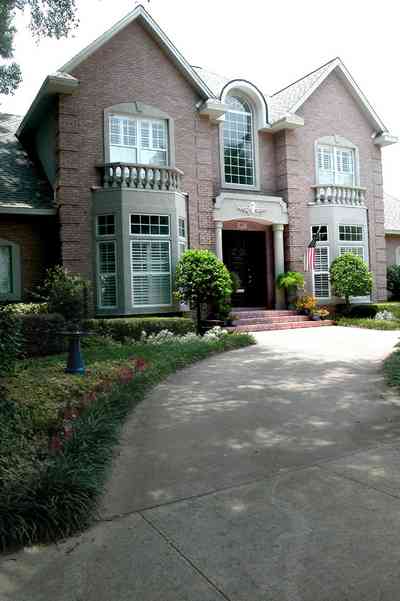
A circular driveway is a central feature of the front yard.
-

This is a view of the home from the corner of Gadsden Street facing south.
-
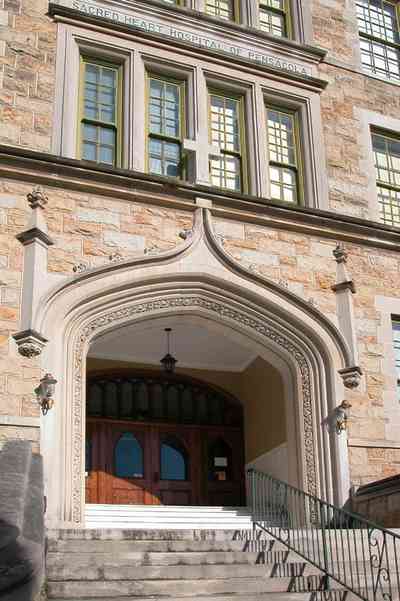
There is 86,000 square feet of space in the old hospital building.
-
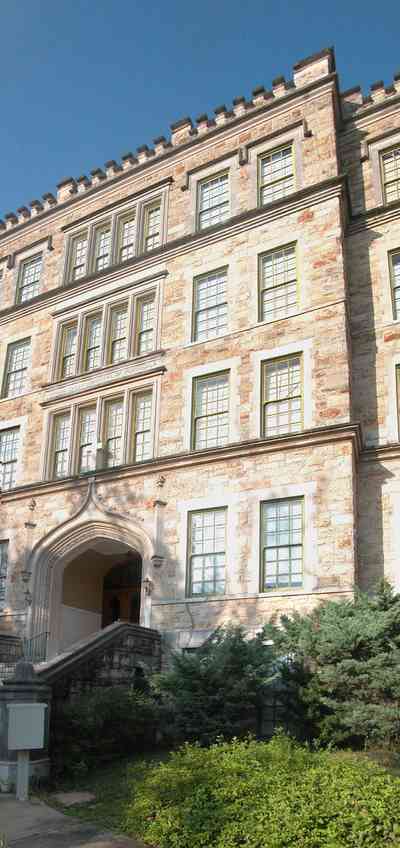
Over 500 casement windows are located in the building.
-

-

Madisons Diner is located on the north side of the building. A variety of southern style soul food is served seven days a week.
-

The front door tracery is enhanced with beveled glass.
-

Large windows line the room on the north side of the top floor. The room was originally used as a sun parlor.
-

Libby Adams perches in the window.
-
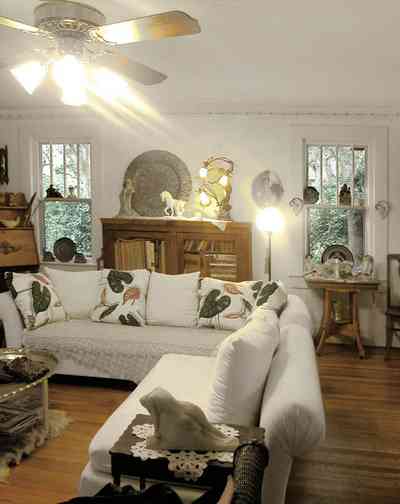
The distinctive Craftsman window has a single pane of glass in the lower sash and several panes in the upper sash. Art Nouveau and Art Deco antiques and Turkish handicrafts from the Berthelot's travels blend with contemporary modular sofas.
-

Two stained glass windows came from an old spaghetti factory in New Orleans.
-

-

This view of the home faces west on Pensacola Bay.
-

The building was formerly used as the Coast Guard Station.
-

The interior of St. Mary's Episcopal Church is rich in detail with elaborate stained glass windows.
-

-

-

-

-

-
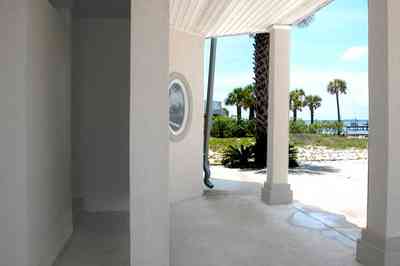
-

There is a wrought-iron fence on the north and east sides of the house. The east facade features the one-story Florida room.
-

Magnolia leaves are the ground cover under the trees.
-

The Florida Room is finished in a unique red-brick trim, accenting the arched windows.
-

The backyard can be seen through the arched doorway.
-

The sunroom is used as a casual family room.
-

The south side of the formal living room overlooks the backyard.
-

-

The elaborate dining room furniture was purchased from Argentina. There are scars from shotgun pellets in several of the seats - remnants of a coup attempt.
-

The stained glass windows are from a convent in Cincinatti, Ohio.
-

The kitchen and breakfast nook adjoins the dining room on the east side of the house.
-

A breakfast nook is located off the kitchen.
-

There is a round window in the garden wall.
-

The small window is decorated with three styles of columns used on the house facade.
-

Full length window open onto the front porch. The facade of the house faces south.
-

The bay window is on the west wall of the house in the front parlor. The pocket door pictured above is on the right of this frame.
-

The view of the palm tree can be seen through the central panel of the bay window in the front west parlor.
-
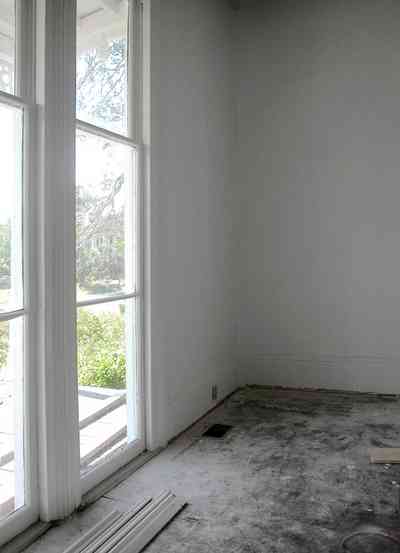
Floor length windows open onto the front porch in the west front parlor.
-

This living space adjoins the west front parlor.
-
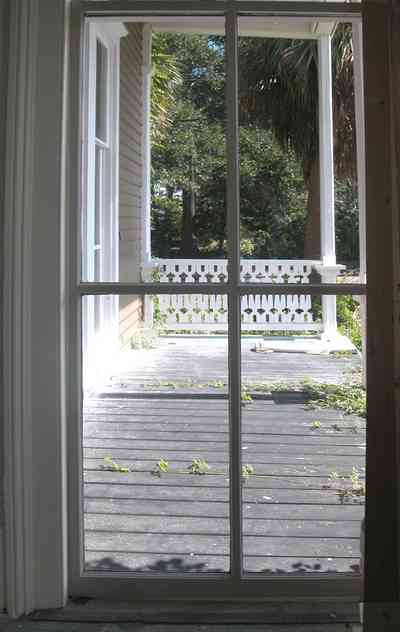
There is a front porch set back on the east side of the facade. This is a view from the central hall.
-

The east parlor has several floor length windows which open onto the front porch.
-

The door to the east front parlor opens off the front hall.
-

Two full length windows frame the east corner of the house in the front parlor.
-

This living room/parlor adjoins the east front parlor.
-

There is a back porch alongside of the kitchen.
-

There is a second floor porch.
-
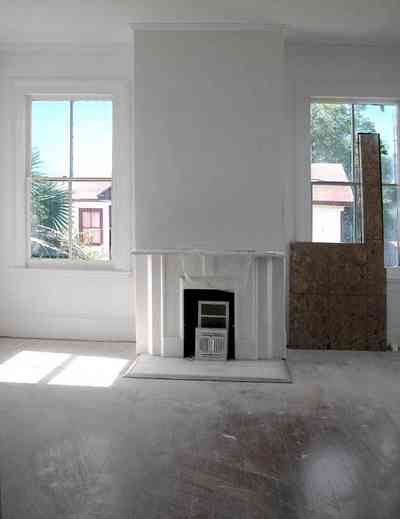
-

-

-

From the second living space on the west side, there is a view of the front porch.
-

The room is on the west side of the house and faces the front porch.
-
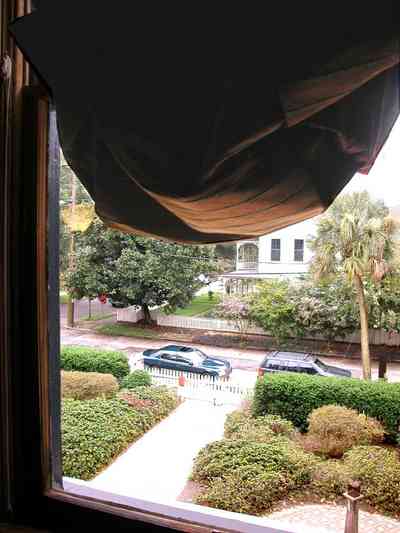
-
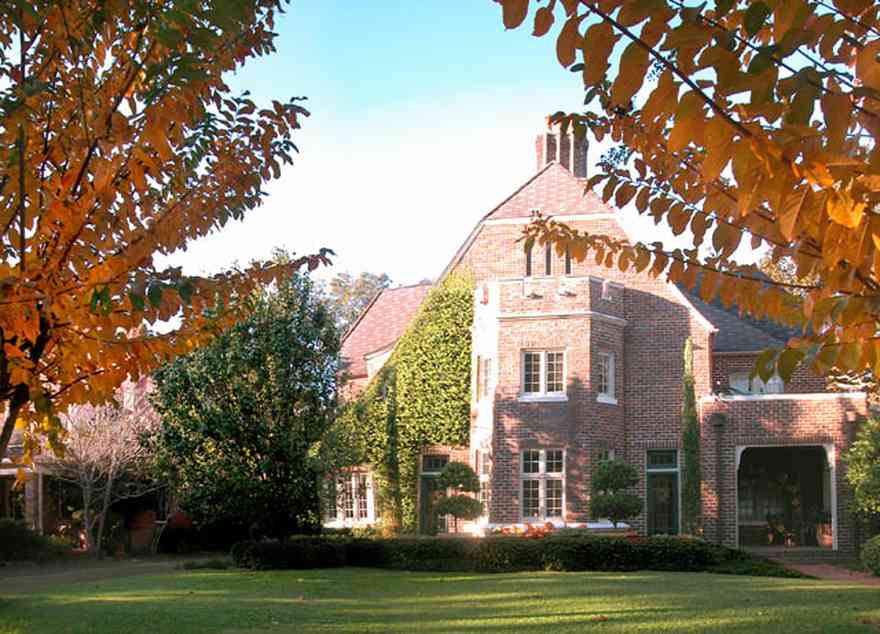
-

-

-
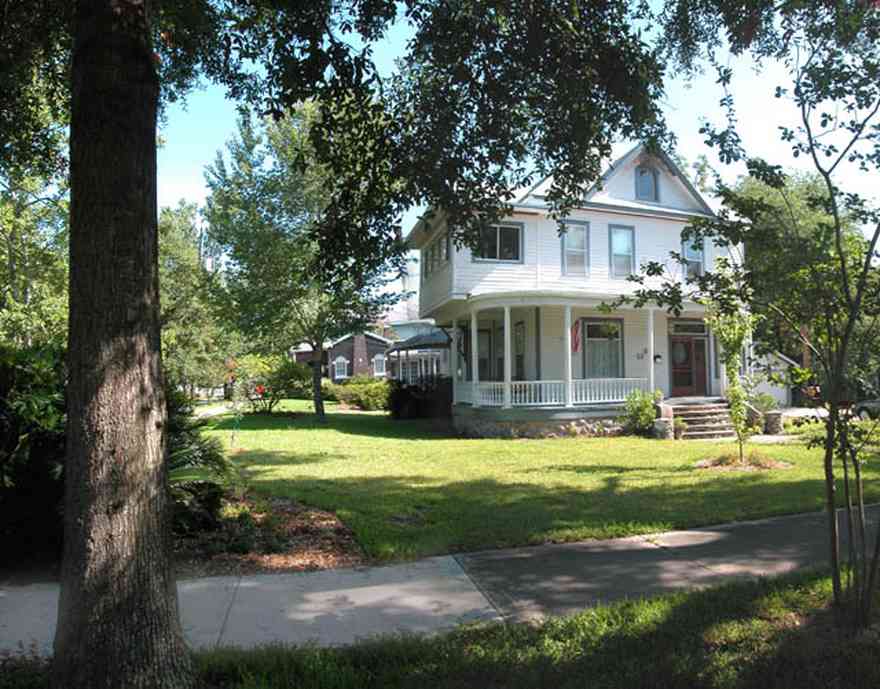
The Queen Anne house has approximately 5000 square feet of living area on three floors. It is located on the northeast corner of Gonzales and Baylen Streets. The property was much larger when the house was built, but an owner during the 1920's sold the backyard to his son because of his desire to have him live close by.
-
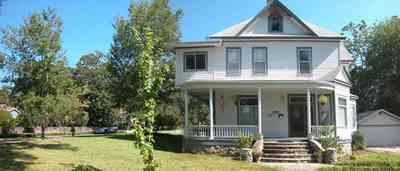
A Florida room was added to the home in 1940 to allow more room for one the quadroplex apartments upstairs. It breaks the Victorian lines of the home but there are no plans to remove the addition.
-

The stone on the exterior of the house were ballast stones thrown ashore by 19th century sailing vessels that were in Pensacola to take on lumber. Stones are commonly used in large North Hill homes.
-
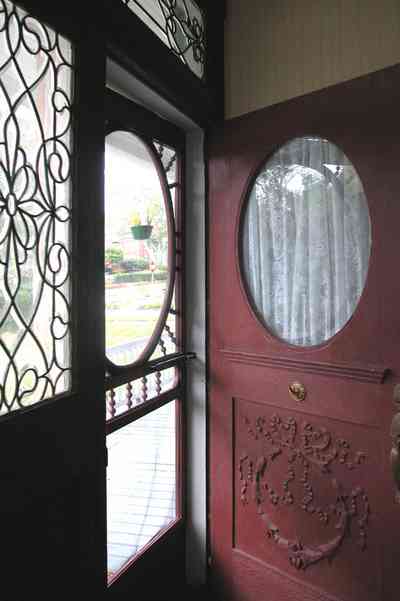
The beveled glass at the entrance and over some of the large bay windows in the house are all original. The front door was originally beveled glass but it was destroyed during an "Animal House" party when aviators rented the house in the 1990s.
-

The stained glass window is original to the house. The window shown is in the front stairwell. A second, duplicate window is below in the stairwell closet ont he first floor.
-

The ship in the east window of the childrens attic playroom shows an etching of one of the sailing ships that frequented Pensacola in the latter quarter of the 19th century to export
lumber.
-
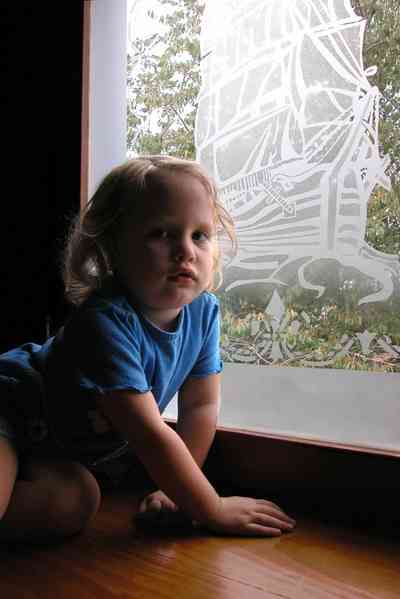
Two year old, Evelyn sits on the east window bench in her attic playroom.
-

-

Trevor rides a rocking horse in his attic playroom. The attic was renovated in 2001 to add another 1000 square feet of living space to the house. The tongue and groove wood flanking both east and west attic windows complement both wings.
-

During October, it is a family tradition to put a jack-o-lantern in the south attic window. "On Halloween, some kids won't come up the sidewalk when they see it illuminated," claims Wesley Odom, the current owner. "If the kids knew there really are ghosts in the house, they certainly wouldn't come."
-

-

The attic turret room is a hexagon.
-

Hopkins House can be seen from the attic windows.
-

The Turner Shop is located on Baylen Street in the North Hill Preservation District, adjacent to downtown Pensacola.
-

The shop is located on the west side of Baylen Street.
-

The appliances were imported from France.
-

-

The building faces Pensacola Bay on two city blocks.
-

A major renovation of the building took place betwen 1878 and 1879. Dr. Scott’s report for 1879 for the Diocese of Florida states that he had a stained glass window “Light of the World” installed over the altar as a memorial to the late Rt. Rev. Francis Huger Rutledge. All of the stained glass windows were moved in 1903 to the new Christ Church where parishioners still enjoy their beauty. A copy of the “Light of the World” window was made by Rambusch, Inc. of New York. The window was given as a memorial to Elby Godwin by his wife Jeanne and their two children, Honey and Elby, Jr.
-

A major renovation of the building took place betwen 1878 and 1879. Dr. Scott’s report for 1879 for the Diocese of Florida states that he had a stained glass window “Light of the World” installed over the altar as a memorial to the late Rt. Rev. Francis Huger Rutledge. All of the stained glass windows were moved in 1903 to the new Christ Church where parishioners still enjoy their beauty. A copy of the “Light of the World” window was made by Rambusch, Inc. of New York. The window was given as a memorial to Elby Godwin by his wife Jeanne and their two children, Honey and Elby, Jr.
-

-

-

-
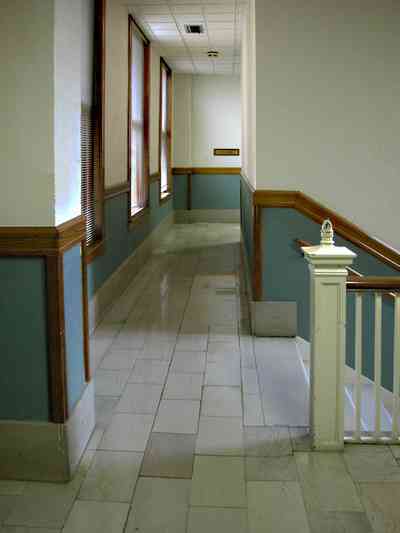
-

-

The church is located on the corner of Chase and Palafox Street in downtown Pensacola.
-

-
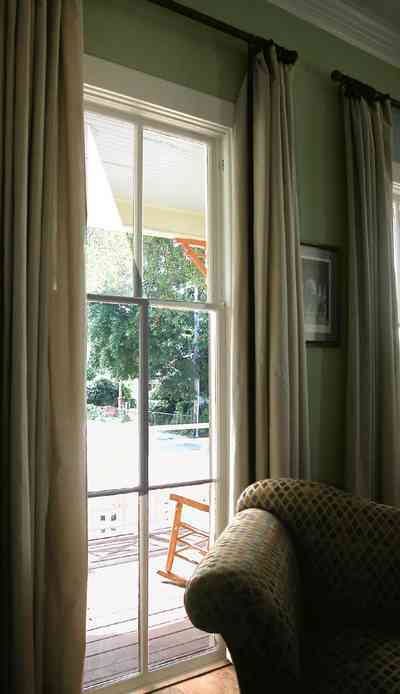
-

-

-

The master bath opens onto the back porch.
-

The door with stained glass was installed by Thorpe, the homeowner in the 1970's. The etched glass central figure is encased by a stained glass frame.
-

A view from the kitchen through to the family room shows the new additon onto the original house. The date of the addition is unknown.
-

The bay window of leaded glass with stained panes is very unusual. It imparts a light airy feeling to the room.
-

The house has no downstairs closets except for under the stairwell access in the dining room. Cabinets, amoires and dressers provide the necessary storage space.
-

The photograph is part of the original survey of the historic district by Historic Pensacola.
-

The floors were imported from a building in Mobile. After Hurricane Georges, parts of the flooring was replaced with planks from the Buggyworks Building on Intendencia that was demolished.
-

The home is a four-square Georgian architectural style. It is located on the north side of East Intendencia Street.
-

The cells to the left are used for children's art classes.
-

The original jail equipment remains in place with the keys still in the locks.
-

The room/cell is used for children's art classes.
-
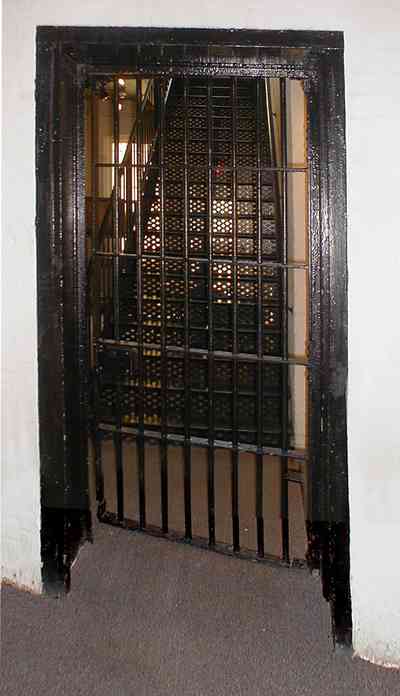
The barred door leads into the hall. Stairs to the second floor are immediately across the hall.
-

There are galleries across the hall from the staircase.
-

The staircase leads to the second floor galleries.
-
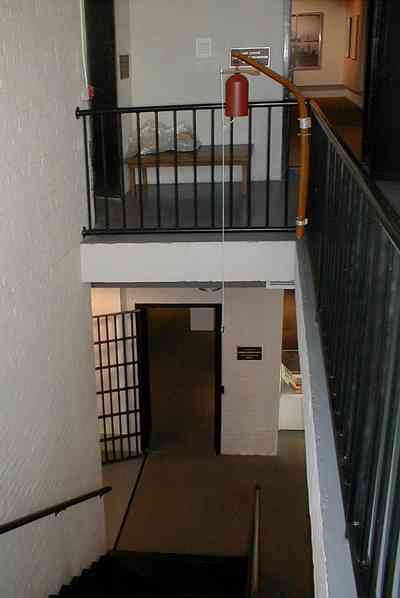
Large galleries are located off the upstairs hall.
-

The stairwell is lit by natural light from the large windows and open staircase.
-
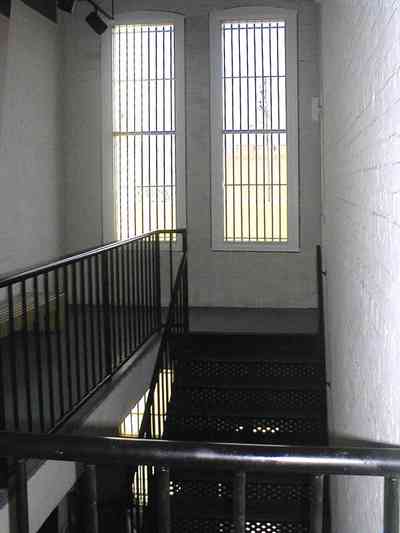
There are large barred windows on the south side of the building.
-

One of the second floor galleries is located off the stairwell.
-

Main Street can be seen out of an upstairs window. The buildings are early 20th century warehouses, now converted into office buildings.
-

Exterior barred windows face Main Street.
-

The exterior walls are finished with stucco.
-
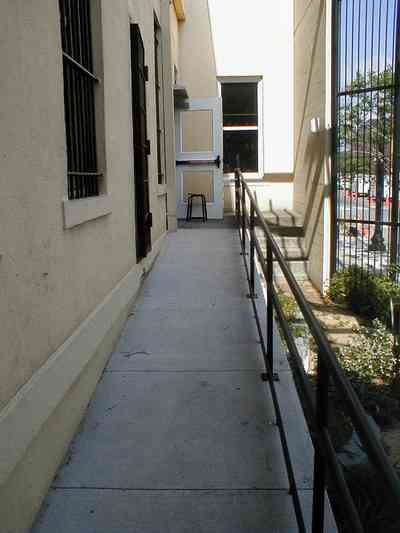
A small sculpture garden is located between the building and the sidewalk on Main Street.
-

Details of the Spanish Revival architecture can be seen along the roof line. As is typical of classical revival in government buildings of the first half of the 20th century, this style owes much to the Beaux Arts interpretation of classical design.
-

Renovations to the building have extended and enhanced the original construction style with additional metal work.
-

-

-

The home is located in the Oak Hollow subdivision.
-

A circular drive is the central feature of the front yard.

 The informal dining area is adjacent to the kitchen. The back door leads out to the rear courtyard and the carriage house or garage. Unlike many houses in Aragon, Ms. Ritchie has chosen not to create a second story to her carriage house in order to preserve her view of Escambia Bay.
The informal dining area is adjacent to the kitchen. The back door leads out to the rear courtyard and the carriage house or garage. Unlike many houses in Aragon, Ms. Ritchie has chosen not to create a second story to her carriage house in order to preserve her view of Escambia Bay.
 The rear storage building can be seen through the kitchen window.
The rear storage building can be seen through the kitchen window. The viewer faces northeast from the vantage point of Forsyth Street in Bagdad, FL.
The viewer faces northeast from the vantage point of Forsyth Street in Bagdad, FL. St. Elizabeth Catholic Church was built in 1923. It is located in north Escambia County.
St. Elizabeth Catholic Church was built in 1923. It is located in north Escambia County. The distinguishing feature of a Neoclassical house is a portico of white classical columns, Ionic, Corinthian or Doric columns, dormer windows, and side porches are elements common to the style of the 1900's to 1940's.
The distinguishing feature of a Neoclassical house is a portico of white classical columns, Ionic, Corinthian or Doric columns, dormer windows, and side porches are elements common to the style of the 1900's to 1940's.







 The entire third floor was used as a ballroom.
The entire third floor was used as a ballroom.
 The circular drive graces the side entrance.
The circular drive graces the side entrance. A circular driveway is a central feature of the front yard.
A circular driveway is a central feature of the front yard. This is a view of the home from the corner of Gadsden Street facing south.
This is a view of the home from the corner of Gadsden Street facing south. There is 86,000 square feet of space in the old hospital building.
There is 86,000 square feet of space in the old hospital building. Over 500 casement windows are located in the building.
Over 500 casement windows are located in the building.
 Madisons Diner is located on the north side of the building. A variety of southern style soul food is served seven days a week.
Madisons Diner is located on the north side of the building. A variety of southern style soul food is served seven days a week. The front door tracery is enhanced with beveled glass.
The front door tracery is enhanced with beveled glass. Large windows line the room on the north side of the top floor. The room was originally used as a sun parlor.
Large windows line the room on the north side of the top floor. The room was originally used as a sun parlor. Libby Adams perches in the window.
Libby Adams perches in the window. The distinctive Craftsman window has a single pane of glass in the lower sash and several panes in the upper sash. Art Nouveau and Art Deco antiques and Turkish handicrafts from the Berthelot's travels blend with contemporary modular sofas.
The distinctive Craftsman window has a single pane of glass in the lower sash and several panes in the upper sash. Art Nouveau and Art Deco antiques and Turkish handicrafts from the Berthelot's travels blend with contemporary modular sofas. Two stained glass windows came from an old spaghetti factory in New Orleans.
Two stained glass windows came from an old spaghetti factory in New Orleans.
 This view of the home faces west on Pensacola Bay.
This view of the home faces west on Pensacola Bay. The building was formerly used as the Coast Guard Station.
The building was formerly used as the Coast Guard Station. The interior of St. Mary's Episcopal Church is rich in detail with elaborate stained glass windows.
The interior of St. Mary's Episcopal Church is rich in detail with elaborate stained glass windows.





 There is a wrought-iron fence on the north and east sides of the house. The east facade features the one-story Florida room.
There is a wrought-iron fence on the north and east sides of the house. The east facade features the one-story Florida room. Magnolia leaves are the ground cover under the trees.
Magnolia leaves are the ground cover under the trees. The Florida Room is finished in a unique red-brick trim, accenting the arched windows.
The Florida Room is finished in a unique red-brick trim, accenting the arched windows. The backyard can be seen through the arched doorway.
The backyard can be seen through the arched doorway. The sunroom is used as a casual family room.
The sunroom is used as a casual family room. The south side of the formal living room overlooks the backyard.
The south side of the formal living room overlooks the backyard.
 The elaborate dining room furniture was purchased from Argentina. There are scars from shotgun pellets in several of the seats - remnants of a coup attempt.
The elaborate dining room furniture was purchased from Argentina. There are scars from shotgun pellets in several of the seats - remnants of a coup attempt. The stained glass windows are from a convent in Cincinatti, Ohio.
The stained glass windows are from a convent in Cincinatti, Ohio. The kitchen and breakfast nook adjoins the dining room on the east side of the house.
The kitchen and breakfast nook adjoins the dining room on the east side of the house. A breakfast nook is located off the kitchen.
A breakfast nook is located off the kitchen. There is a round window in the garden wall.
There is a round window in the garden wall. The small window is decorated with three styles of columns used on the house facade.
The small window is decorated with three styles of columns used on the house facade. Full length window open onto the front porch. The facade of the house faces south.
Full length window open onto the front porch. The facade of the house faces south. The bay window is on the west wall of the house in the front parlor. The pocket door pictured above is on the right of this frame.
The bay window is on the west wall of the house in the front parlor. The pocket door pictured above is on the right of this frame. The view of the palm tree can be seen through the central panel of the bay window in the front west parlor.
The view of the palm tree can be seen through the central panel of the bay window in the front west parlor. Floor length windows open onto the front porch in the west front parlor.
Floor length windows open onto the front porch in the west front parlor. This living space adjoins the west front parlor.
This living space adjoins the west front parlor. There is a front porch set back on the east side of the facade. This is a view from the central hall.
There is a front porch set back on the east side of the facade. This is a view from the central hall. The east parlor has several floor length windows which open onto the front porch.
The east parlor has several floor length windows which open onto the front porch. The door to the east front parlor opens off the front hall.
The door to the east front parlor opens off the front hall. Two full length windows frame the east corner of the house in the front parlor.
Two full length windows frame the east corner of the house in the front parlor. This living room/parlor adjoins the east front parlor.
This living room/parlor adjoins the east front parlor. There is a back porch alongside of the kitchen.
There is a back porch alongside of the kitchen. There is a second floor porch.
There is a second floor porch.


 From the second living space on the west side, there is a view of the front porch.
From the second living space on the west side, there is a view of the front porch. The room is on the west side of the house and faces the front porch.
The room is on the west side of the house and faces the front porch.



 The Queen Anne house has approximately 5000 square feet of living area on three floors. It is located on the northeast corner of Gonzales and Baylen Streets. The property was much larger when the house was built, but an owner during the 1920's sold the backyard to his son because of his desire to have him live close by.
The Queen Anne house has approximately 5000 square feet of living area on three floors. It is located on the northeast corner of Gonzales and Baylen Streets. The property was much larger when the house was built, but an owner during the 1920's sold the backyard to his son because of his desire to have him live close by. A Florida room was added to the home in 1940 to allow more room for one the quadroplex apartments upstairs. It breaks the Victorian lines of the home but there are no plans to remove the addition.
A Florida room was added to the home in 1940 to allow more room for one the quadroplex apartments upstairs. It breaks the Victorian lines of the home but there are no plans to remove the addition. The stone on the exterior of the house were ballast stones thrown ashore by 19th century sailing vessels that were in Pensacola to take on lumber. Stones are commonly used in large North Hill homes.
The stone on the exterior of the house were ballast stones thrown ashore by 19th century sailing vessels that were in Pensacola to take on lumber. Stones are commonly used in large North Hill homes. The beveled glass at the entrance and over some of the large bay windows in the house are all original. The front door was originally beveled glass but it was destroyed during an "Animal House" party when aviators rented the house in the 1990s.
The beveled glass at the entrance and over some of the large bay windows in the house are all original. The front door was originally beveled glass but it was destroyed during an "Animal House" party when aviators rented the house in the 1990s. The stained glass window is original to the house. The window shown is in the front stairwell. A second, duplicate window is below in the stairwell closet ont he first floor.
The stained glass window is original to the house. The window shown is in the front stairwell. A second, duplicate window is below in the stairwell closet ont he first floor. The ship in the east window of the childrens attic playroom shows an etching of one of the sailing ships that frequented Pensacola in the latter quarter of the 19th century to export lumber.
The ship in the east window of the childrens attic playroom shows an etching of one of the sailing ships that frequented Pensacola in the latter quarter of the 19th century to export lumber. Two year old, Evelyn sits on the east window bench in her attic playroom.
Two year old, Evelyn sits on the east window bench in her attic playroom.
 Trevor rides a rocking horse in his attic playroom. The attic was renovated in 2001 to add another 1000 square feet of living space to the house. The tongue and groove wood flanking both east and west attic windows complement both wings.
Trevor rides a rocking horse in his attic playroom. The attic was renovated in 2001 to add another 1000 square feet of living space to the house. The tongue and groove wood flanking both east and west attic windows complement both wings. During October, it is a family tradition to put a jack-o-lantern in the south attic window. "On Halloween, some kids won't come up the sidewalk when they see it illuminated," claims Wesley Odom, the current owner. "If the kids knew there really are ghosts in the house, they certainly wouldn't come."
During October, it is a family tradition to put a jack-o-lantern in the south attic window. "On Halloween, some kids won't come up the sidewalk when they see it illuminated," claims Wesley Odom, the current owner. "If the kids knew there really are ghosts in the house, they certainly wouldn't come."
 The attic turret room is a hexagon.
The attic turret room is a hexagon. Hopkins House can be seen from the attic windows.
Hopkins House can be seen from the attic windows. The Turner Shop is located on Baylen Street in the North Hill Preservation District, adjacent to downtown Pensacola.
The Turner Shop is located on Baylen Street in the North Hill Preservation District, adjacent to downtown Pensacola. The shop is located on the west side of Baylen Street.
The shop is located on the west side of Baylen Street. The appliances were imported from France.
The appliances were imported from France.
 The building faces Pensacola Bay on two city blocks.
The building faces Pensacola Bay on two city blocks. A major renovation of the building took place betwen 1878 and 1879. Dr. Scott’s report for 1879 for the Diocese of Florida states that he had a stained glass window “Light of the World” installed over the altar as a memorial to the late Rt. Rev. Francis Huger Rutledge. All of the stained glass windows were moved in 1903 to the new Christ Church where parishioners still enjoy their beauty. A copy of the “Light of the World” window was made by Rambusch, Inc. of New York. The window was given as a memorial to Elby Godwin by his wife Jeanne and their two children, Honey and Elby, Jr.
A major renovation of the building took place betwen 1878 and 1879. Dr. Scott’s report for 1879 for the Diocese of Florida states that he had a stained glass window “Light of the World” installed over the altar as a memorial to the late Rt. Rev. Francis Huger Rutledge. All of the stained glass windows were moved in 1903 to the new Christ Church where parishioners still enjoy their beauty. A copy of the “Light of the World” window was made by Rambusch, Inc. of New York. The window was given as a memorial to Elby Godwin by his wife Jeanne and their two children, Honey and Elby, Jr. A major renovation of the building took place betwen 1878 and 1879. Dr. Scott’s report for 1879 for the Diocese of Florida states that he had a stained glass window “Light of the World” installed over the altar as a memorial to the late Rt. Rev. Francis Huger Rutledge. All of the stained glass windows were moved in 1903 to the new Christ Church where parishioners still enjoy their beauty. A copy of the “Light of the World” window was made by Rambusch, Inc. of New York. The window was given as a memorial to Elby Godwin by his wife Jeanne and their two children, Honey and Elby, Jr.
A major renovation of the building took place betwen 1878 and 1879. Dr. Scott’s report for 1879 for the Diocese of Florida states that he had a stained glass window “Light of the World” installed over the altar as a memorial to the late Rt. Rev. Francis Huger Rutledge. All of the stained glass windows were moved in 1903 to the new Christ Church where parishioners still enjoy their beauty. A copy of the “Light of the World” window was made by Rambusch, Inc. of New York. The window was given as a memorial to Elby Godwin by his wife Jeanne and their two children, Honey and Elby, Jr.




 The church is located on the corner of Chase and Palafox Street in downtown Pensacola.
The church is located on the corner of Chase and Palafox Street in downtown Pensacola.



 The master bath opens onto the back porch.
The master bath opens onto the back porch. The door with stained glass was installed by Thorpe, the homeowner in the 1970's. The etched glass central figure is encased by a stained glass frame.
The door with stained glass was installed by Thorpe, the homeowner in the 1970's. The etched glass central figure is encased by a stained glass frame. A view from the kitchen through to the family room shows the new additon onto the original house. The date of the addition is unknown.
A view from the kitchen through to the family room shows the new additon onto the original house. The date of the addition is unknown. The bay window of leaded glass with stained panes is very unusual. It imparts a light airy feeling to the room.
The bay window of leaded glass with stained panes is very unusual. It imparts a light airy feeling to the room. The house has no downstairs closets except for under the stairwell access in the dining room. Cabinets, amoires and dressers provide the necessary storage space.
The house has no downstairs closets except for under the stairwell access in the dining room. Cabinets, amoires and dressers provide the necessary storage space. The photograph is part of the original survey of the historic district by Historic Pensacola.
The photograph is part of the original survey of the historic district by Historic Pensacola. The floors were imported from a building in Mobile. After Hurricane Georges, parts of the flooring was replaced with planks from the Buggyworks Building on Intendencia that was demolished.
The floors were imported from a building in Mobile. After Hurricane Georges, parts of the flooring was replaced with planks from the Buggyworks Building on Intendencia that was demolished. The home is a four-square Georgian architectural style. It is located on the north side of East Intendencia Street.
The home is a four-square Georgian architectural style. It is located on the north side of East Intendencia Street. The cells to the left are used for children's art classes.
The cells to the left are used for children's art classes. The original jail equipment remains in place with the keys still in the locks.
The original jail equipment remains in place with the keys still in the locks. The room/cell is used for children's art classes.
The room/cell is used for children's art classes. The barred door leads into the hall. Stairs to the second floor are immediately across the hall.
The barred door leads into the hall. Stairs to the second floor are immediately across the hall. There are galleries across the hall from the staircase.
There are galleries across the hall from the staircase. The staircase leads to the second floor galleries.
The staircase leads to the second floor galleries. Large galleries are located off the upstairs hall.
Large galleries are located off the upstairs hall. The stairwell is lit by natural light from the large windows and open staircase.
The stairwell is lit by natural light from the large windows and open staircase. There are large barred windows on the south side of the building.
There are large barred windows on the south side of the building. One of the second floor galleries is located off the stairwell.
One of the second floor galleries is located off the stairwell. Main Street can be seen out of an upstairs window. The buildings are early 20th century warehouses, now converted into office buildings.
Main Street can be seen out of an upstairs window. The buildings are early 20th century warehouses, now converted into office buildings. Exterior barred windows face Main Street.
Exterior barred windows face Main Street. The exterior walls are finished with stucco.
The exterior walls are finished with stucco. A small sculpture garden is located between the building and the sidewalk on Main Street.
A small sculpture garden is located between the building and the sidewalk on Main Street. Details of the Spanish Revival architecture can be seen along the roof line. As is typical of classical revival in government buildings of the first half of the 20th century, this style owes much to the Beaux Arts interpretation of classical design.
Details of the Spanish Revival architecture can be seen along the roof line. As is typical of classical revival in government buildings of the first half of the 20th century, this style owes much to the Beaux Arts interpretation of classical design. Renovations to the building have extended and enhanced the original construction style with additional metal work.
Renovations to the building have extended and enhanced the original construction style with additional metal work.

 The home is located in the Oak Hollow subdivision.
The home is located in the Oak Hollow subdivision. A circular drive is the central feature of the front yard.
A circular drive is the central feature of the front yard. One Tank of Gas
One Tank of Gas